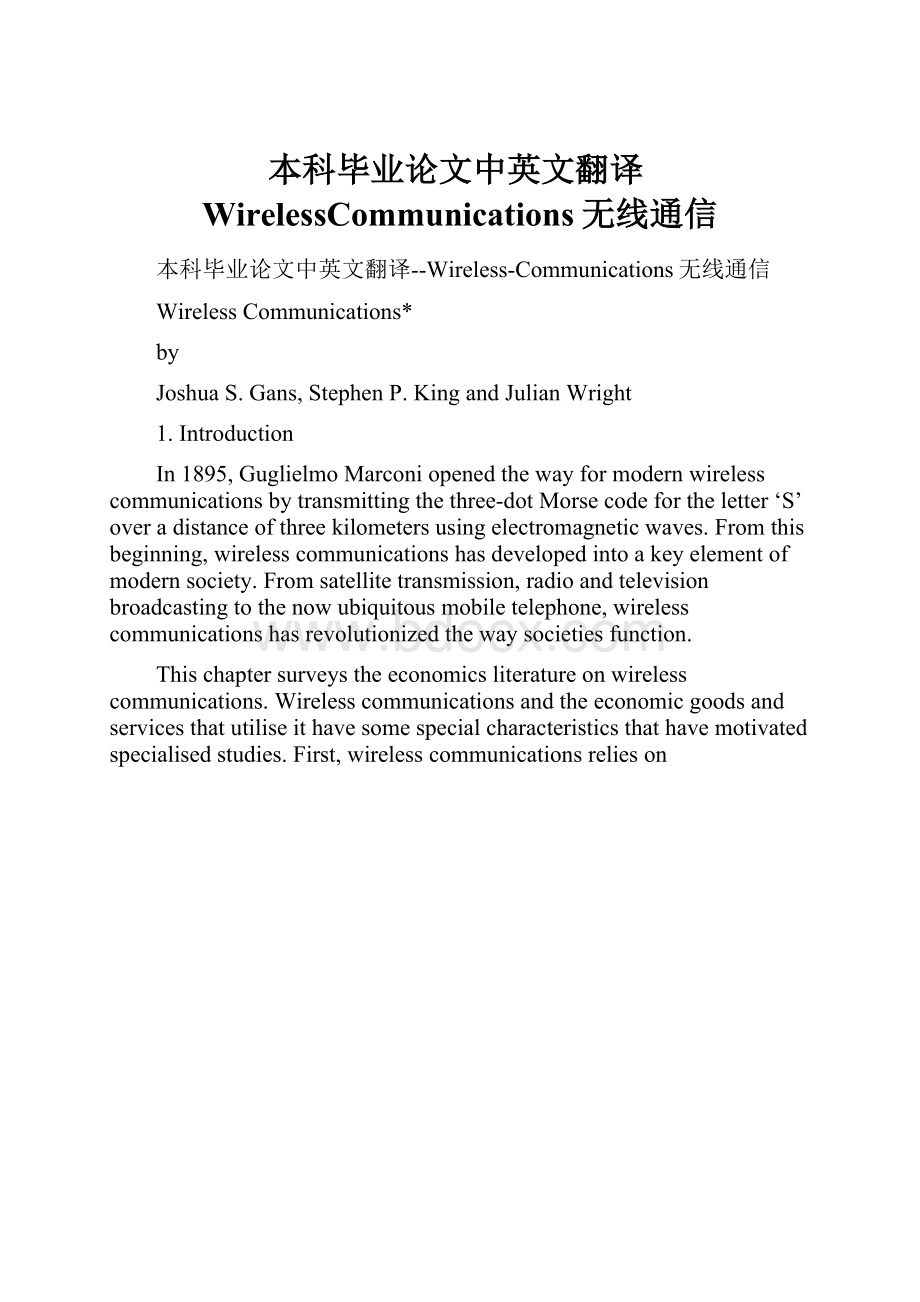 本科毕业论文中英文翻译WirelessCommunications无线通信.docx
本科毕业论文中英文翻译WirelessCommunications无线通信.docx
- 文档编号:25870933
- 上传时间:2023-06-16
- 格式:DOCX
- 页数:23
- 大小:134.32KB
本科毕业论文中英文翻译WirelessCommunications无线通信.docx
《本科毕业论文中英文翻译WirelessCommunications无线通信.docx》由会员分享,可在线阅读,更多相关《本科毕业论文中英文翻译WirelessCommunications无线通信.docx(23页珍藏版)》请在冰豆网上搜索。

本科毕业论文中英文翻译WirelessCommunications无线通信
本科毕业论文中英文翻译--Wireless-Communications无线通信
WirelessCommunications*
by
JoshuaS.Gans,StephenP.KingandJulianWright
1.Introduction
In1895,GuglielmoMarconiopenedthewayformodernwirelesscommunicationsbytransmittingthethree-dotMorsecodefortheletter‘S’overadistanceofthreekilometersusingelectromagneticwaves.Fromthisbeginning,wirelesscommunicationshasdevelopedintoakeyelementofmodernsociety.Fromsatellitetransmission,radioandtelevisionbroadcastingtothenowubiquitousmobiletelephone,wirelesscommunicationshasrevolutionizedthewaysocietiesfunction.
Thischaptersurveystheeconomicsliteratureonwirelesscommunications.Wirelesscommunicationsandtheeconomicgoodsandservicesthatutiliseithavesomespecialcharacteristicsthathavemotivatedspecialisedstudies.First,wirelesscommunicationsrelieson
communicationtechnologies.Section3thenconsiderstheeconomicissuesassociatedwithmobiletelephonyincludingspectrumallocationandstandards.Section4surveysrecenteconomicstudiesofthediffusionofmobiletelephony.Finally,section5reviewsissuesofregulationandcompetition;inparticular,theneedforandprinciplesbehindaccesspricingformobilephonenetworks.
2.Background
Marconi’spioneeringworkquicklyledtovarietyofcommercialandgovernment(particularlymilitary)developmentsandinnovations.Intheearly1900s,voiceandthenmusicwastransmittedandmodernradiowasborn.By1920,commercialradiohadbeenestablishedwithDetroitstationWWJandKDKAinPittsburgh.Wirelesstelegraphywas
firstusedbytheBritishmilitaryinSouthAfricain1900duringtheAnglo-Boerwar.TheBritishnavyusedequipmentsuppliedbyMarconitocommunicatebetweenshipsinDelagoaBay.ShippingwasamajorearlyclientforwirelesstelegraphyandwirelesswasstandardforshippingbythetimetheTitanicissueditsradiodistresscallsin1912.1
Earlyon,itwasquicklyrecognizedthatinternationalcoordinationwasrequiredforwirelesscommunicationtobeeffective.Thiscoordinationinvolvedtwofeatures.First,thepotentialforinterferenceinradiotransmissionsmeantthatatleastlocalcoordinationwasneededtoavoidthetransmissionofconflictingsignals.Secondly,withspectrumtobeusedforinternationalcommunicationsandareassuchasmaritimesafetyandnavigation,coordinationwasnecessarybetweencountriestoguaranteeconsistencyinapproachtotheseservices.Thisdrovegovernmentinterventiontoensurethecoordinatedallocationofradiospectrum.
2.1SpectrumAllocation
Radiotransmissioninvolvestheuseofpartoftheelectromagneticspectrum.Electromagneticenergyistransmittedindifferentfrequenciesandthepropertiesoftheenergydependonthefrequency.Forexample,visiblelighthasafrequencybetween4×1014and7.5×1014Hz.2Ultravioletradiation,X-raysandgammarayshavehigherfrequencies(orequivalentlyashorterwavelength)whileinfraredradiation,microwavesandradiowaveshavelowerfrequencies(longerwavelengths).Theradiofrequencyspectruminvolveselectromagneticradiationwithfrequenciesbetween3000Hzand300GHz.3
Evenwithintheradiospectrum,differentfrequencieshavedifferentproperties.AsCave(2001)notes,thehigherthefrequency,theshorterthedistancethesignalwilltravel,butthegreaterthecapacityofthesignaltocarrydata.Thetasksofinternationallycoordinatingtheuseofradiospectrum,managinginterferenceandsettingglobalstandardsareundertakenbytheInternationalTelecommunicationUnion(ITU).TheITUwascreatedbytheInternationalTelecommunicationsConventionin1947buthaspredecessorsdatingbacktoapproximately1865.4ItisaspecialistagencyoftheUnitedNationswithover180members.
TheRadiocommunicationSectoroftheITUcoordinatesglobalspectrumusethroughtheRadioRegulations.Theseregulationswerefirstputinplaceatthe1906BerlinInternationalRadiotelegraphConference.Allocationoftheradiospectrumoccursalongthreedimensions–thefrequency,thegeographiclocationandthepriorityoftheuserwithregardstointerference.Theradiospectrumisbrokenintoeightfrequencybands,rangingfromVeryLowFrequency(3to30kHz)uptoExtremelyHighFrequency(30to300GHz).Geographically,theworldisalsodividedintothreeregions.TheITUthenallocatescertainfrequenciesforspecificusesoneitheraworldwideoraregionalbasis.IndividualcountriesmaythenfurtherallocatefrequencieswithintheITUinternationalallocation.Forexample,intheUnitedStates,theFederalCommunicationsCommission’s(FCC’s)tableoffrequencyallocationsisderivedfromboththeinternationaltableofallocationsandU.S.allocations.Usersarebrokenintoprimaryandsecondaryservices,withprimaryusersprotectedfrominterferencefromsecondaryusersbutnotviceversa.
Asanexample,in2003,thebandbelow9kHzwasnotallocatedintheinternationalortheU.S.table.9to14kHzwasallocatedtoradionavigationinbothtablesandallinternationalregionswhile14to70kHzisallocatedwithbothmaritimecommunicationsandfixedwirelesscommunicationsasprimaryusers.Thereisalsoaninternationaltimesignalat20kHz.ButtheU.S.tablealsoaddsanadditionaltimefrequencyat60kHz.Internationalregionaldistinctionsbegintoappearinthe70to90kHzrangewithdifferencesinuseandprioritybetweenradionavigation,fixed,radiolocationandmaritimemobileuses.Theseallocationscontinuerightupto300GHz,withfrequenciesabove300GHznotallocatedintheUnitedStatesandthoseabove275GHznotallocatedintheinternationaltable.5
TheITUdealswithinterferencebyrequiringmembercountriestofollownotificationandregistrationprocedureswhenevertheyplantoassignfrequencytoaparticularuse,suchasaradiostationoranewsatellite.
2.2Therangeofwirelessservices
Radiospectrumisusedforawiderangeofservices.Thesecanbebrokenintothefollowingbroadclasses:
•Broadcastingservices:
includingshortwave,AMandFMradioaswellasterrestrialtelevision;
•Mobilecommunicationsofvoiceanddata:
includingmaritimeandaeronauticalmobileforcommunicationsbetweenships,airplanesandland;landmobileforcommunicationsbetweenafixedbasestationandmovingsitessuchasataxifleetandpagingservices,andmobilecommunicationseitherbetweenmobileusersandafixednetworkorbetweenmobileusers,suchasmobiletelephoneservices;
•FixedServices:
eitherpointtopointorpointtomultipointservices;
•Satellite:
usedforbroadcasting,telecommunicationsandinternet,particularlyoverlongdistances;
•Amateurradio;
•OtherUses:
includingmilitary,radioastronomy,meteorologicalandscientificuses.6
Theamountofspectrumallocatedtothesedifferentusesdiffersbycountryandfrequencyband.Forexample,intheU.K.,40%ofthe88MHzto1GHzbandoffrequenciesareusedforTVbroadcasting,22%fordefense,10%forGSMmobileand1%formaritimecommunications.Incontrast,noneofthe1GHzto3GHzfrequencyrangeisusedfortelevision,19%isallocatedtoGSMandthird-generationmobilephones,17%todefenseand23%foraeronauticalradar.7
Thenumberofdifferentdevicesusingwirelesscommunicationsisrisingrapidly.Sensorsandembeddedwirelesscontrollersareincreasinglyusedinavarietyofappliancesandapplications.Personaldigitalassistants(PDAs)andmobilecomputersareregularlyconnectedtoe-mailandinternetservicesthroughwirelesscommunications,andwirelesslocalareanetworksforcomputersarebecomingcommoninpublicareaslikeairportlounges.However,byfarthemostimportantanddramaticchangeintheuseof
wirelesscommunicationsinthepasttwentyyearshasbeentheriseofthemobiletelephone.
2.3Theriseandriseofmobiletelephony
Thehistoryofmobiletelephonescanbebrokenintofourperiods.Thefirst(pre-cellular)periodinvolvedmobiletelephonesthatexclusivelyusedafrequencybandinaparticulararea.Thesetelephoneshadsevereproblemswithcongestionandcallcompletion.Ifonecustomerwasusingaparticularfrequencyinageographicarea,noothercustomercouldmakeacallonthatsamefrequency.Further,thenumberoffrequenciesallocatedbytheFCCintheU.S.tomobiletelephoneserviceswassmall,limitingthenumberofsimultaneouscalls.Similarsystems,knownasA-NetzandB-NetzweredevelopedinGermany.
Theintroductionofcellulartechnologygreatlyexpandedtheefficiencyoffrequencyuseofmobilephones.Ratherthanexclusivelyallocatingabandoffrequencytoonetelephonecallinalargegeographicarea,acelltelephonebreaksdownageographicareaintosmallareasorcells.Differentusersindifferent(non-adjacent)cellsareabletousethesamefrequencyforacallwithoutinterference.
Firstgenerationcellularmobiletelephonesdevelopedaroundtheworldusingdifferent,incompatibleanaloguetechnologies.Forexample,inthe1980sintheU.S.therewastheAdvancedMobilePhoneSystem(AMPS),theU.K.hadtheTotalAccessCommunicationsSystem(TACS),GermanydevelopedC-Netz,whileScandinaviadevelopedtheNordicMobileTelephone(NMT)system.Theresultwasawiderangeoflargelyincompatiblesystems,particularlyinEurope,althoughthesingleAMPSsystemwasusedthroughouttheU.S.
Secondgeneration(2G)mobiletelephonesuseddigitaltechnology.TheadoptionofsecondgenerationtechnologydifferedsubstantiallybetweentheUnitedStatesandEuropeandreversestheearlieranaloguemobileexperience.InEurope,acommonstandardwasadopted,partlyduetogovernmentintervention.
GroupeSpecialeMobile(GSM)wasfirstdevelopedinthe1
- 配套讲稿:
如PPT文件的首页显示word图标,表示该PPT已包含配套word讲稿。双击word图标可打开word文档。
- 特殊限制:
部分文档作品中含有的国旗、国徽等图片,仅作为作品整体效果示例展示,禁止商用。设计者仅对作品中独创性部分享有著作权。
- 关 键 词:
- 本科 毕业论文 中英文 翻译 WirelessCommunications 无线通信
 冰豆网所有资源均是用户自行上传分享,仅供网友学习交流,未经上传用户书面授权,请勿作他用。
冰豆网所有资源均是用户自行上传分享,仅供网友学习交流,未经上传用户书面授权,请勿作他用。


 《 岁婴幼儿教养方案》.docx
《 岁婴幼儿教养方案》.docx
